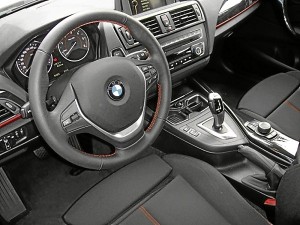
The 1 Series is BMW's second-best-selling model in the Philippines after the 3 Series. Red linings on the steering wheel and dash (above) distinguishes the 118d Sport. AIDA SEVILLA MENDOZA
It may not be stunningly beautiful, but the BMW 1 Series is still a winner—it’s the one that helps to keep BMW No. 1 in the premium car market. At a press briefing last week, Asian Carmakers Corp. (ACC), the official importer and distributor of BMW in the Philippines, announced that in 2011, the 1 Series was BMW’s second-best-selling model after the 3 Series and contributed to the 19-percent increase in year-on-year sales for 2011.
ACC claimed that the 1 Series dominated its segment with year-to-year unit sales of 147, a 141-percent jump from the 2010 figures that further increased its share of the premium compact car category to 54 percent. In the premium luxury car market, BMW cornered 33-percent share in 2011, marking its leadership therein for the ninth consecutive year. Globally, BMW brand sales rose 12.8 percent in 2011 to a total of 1,380,384 vehicles, the highest sales level in BMW history.
Building upon its success as a growth driver, ACC launched the second-generation 1 Series last November, the first to offer the new “line” concept as it is available in either the standard, the Urban or the Sport line. The 2012 116i standard or basic line retails at P2,290,000, the Urban 118d line sells at P2,490,000, and the top-of-the-line 118d Sport costs P2,690,000.
Twin Power Turbo. The baby Bimmer commands a premium price not only because it is a BMW but also because all three lines have the following as standard equipment: Auto Start/Stop function, Brake Energy Regeneration (perhaps a hydraulic brake derivative of the KERS or Kinetic Energy Recovery System used in Formula One racing), BMW Twin Power Turbo Technology, BMW Professional audio system, iDrive system with 6.5-inch display, Bluetooth connectivity and air conditioner.
The 2012 BMW 118d Sport, which I test-drove during a weekend last month, is powered by a 2.0 liter diesel engine mated to an 8-speed automatic transmission. Capable of producing 141 bhp and 320 Nm max torque, it can scoot from zero to 100 kph in 8.9 seconds and is said to consume only 4.4 l per 100 km, thanks to Twin Power Turbo Technology and the Auto Start/ Stop function that automatically shuts off the engine when the car stops at a red light or idles. A slight tap of the driver’s foot on the accelerator pedal quickly restarts the engine.
The new 1 Series is 85 mm longer and 17 mm wider than the first gen 1 Series and has 30 mm more in the wheelbase. The suspension consists of MacPherson struts up front and multilink at the rear. Despite the car’s increased length and wider track, however, legroom for rear seat passengers is still cramped and the rear headrests and seat cushion felt hard. This is a driver-oriented car, obviously, with the dash tilted toward the driver and an excellent driving position. The materials in the cockpit, whether leather or plastic, have a premium feel and headroom is just sufficient.
Immense Joy. But you’ll soon forget about the exterior design and interior space inadequacies once you get behind the wheel. You will discover to your delight that the 1 Series brings immense joy to the driving experience whether barreling down straights or careening around corners. The 118d Sport is utterly playful, the most fun to drive in the premium compact car segment, with its well-balanced chassis, its refined twin turbo diesel engine willingly revving past 5,000 rpm if you so wish and its sports car-like handling.
The 118d Sport’s peak horsepower is rated at 141, but it feels like it can deliver more. The availability of four driving options—ECO PRO, Comfort, Sport and Sport Plus—to suit your mood and/or the prevailing traffic situation enhances the driving pleasure. To increase fuel economy and be environmentally friendly, press the ECO PRO button. If you want to relax and exert less effort in driving, press the Comfort button. This will result in a softer suspension setup via more damping, increased electromechanical servo-assisted steering and earlier upshifts.
Selecting the Sport option stiffens the suspension, reduces steering assist while affording more weighted steering, adjusts throttle response and keeps the transmission in lower gear for a longer period of time before it upshifts. You get a more connected feeling from the suspension and the sportier transmission setting.
Sport Plus. For the driving enthusiast, Sport Plus is the obvious choice. It makes the transmission more aggressive and keeps it well above 4,000 or 5,000 rpm without any upshifts. Steering is less refined and the suspension lets you feel almost everything that’s rushing underneath the car. But naturally, Sport Plus fun consumes more fuel than the ECO PRO mode.
Summing up, the 1 Series 118d Sport is neither a true sports car nor truly an entry-level luxury car because of its high price. Plus its small cabin and limited cargo space make it impractical for a family of four going on a long trip. But it is extremely well-built and the best driver’s car in its class while at the same time offering exceptional fuel economy. If you happen to have P2.7 million to spare, consider this diesel baby Bimmer.
Today’S Bumper Sticker: Money is a good servant, but a poor master.